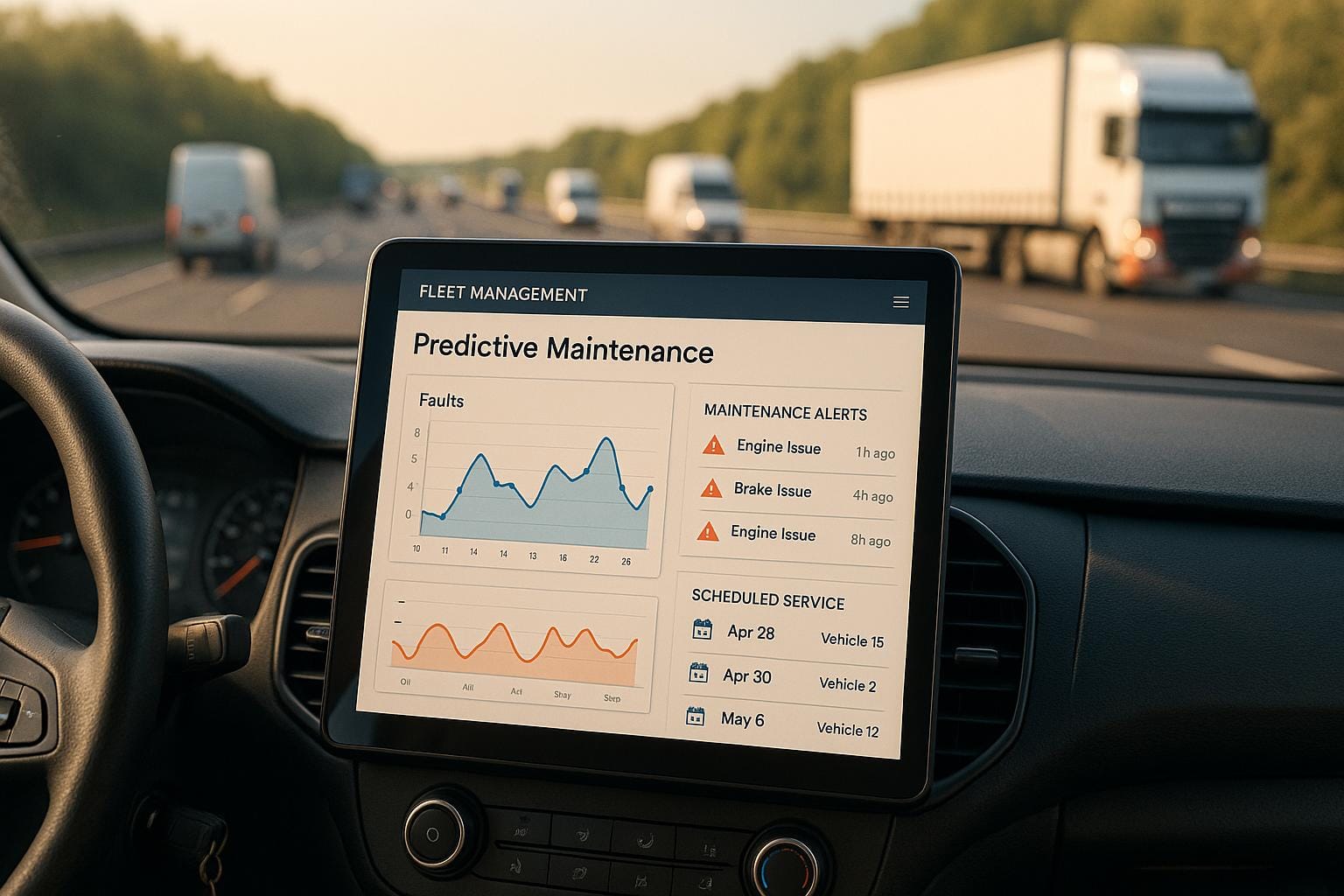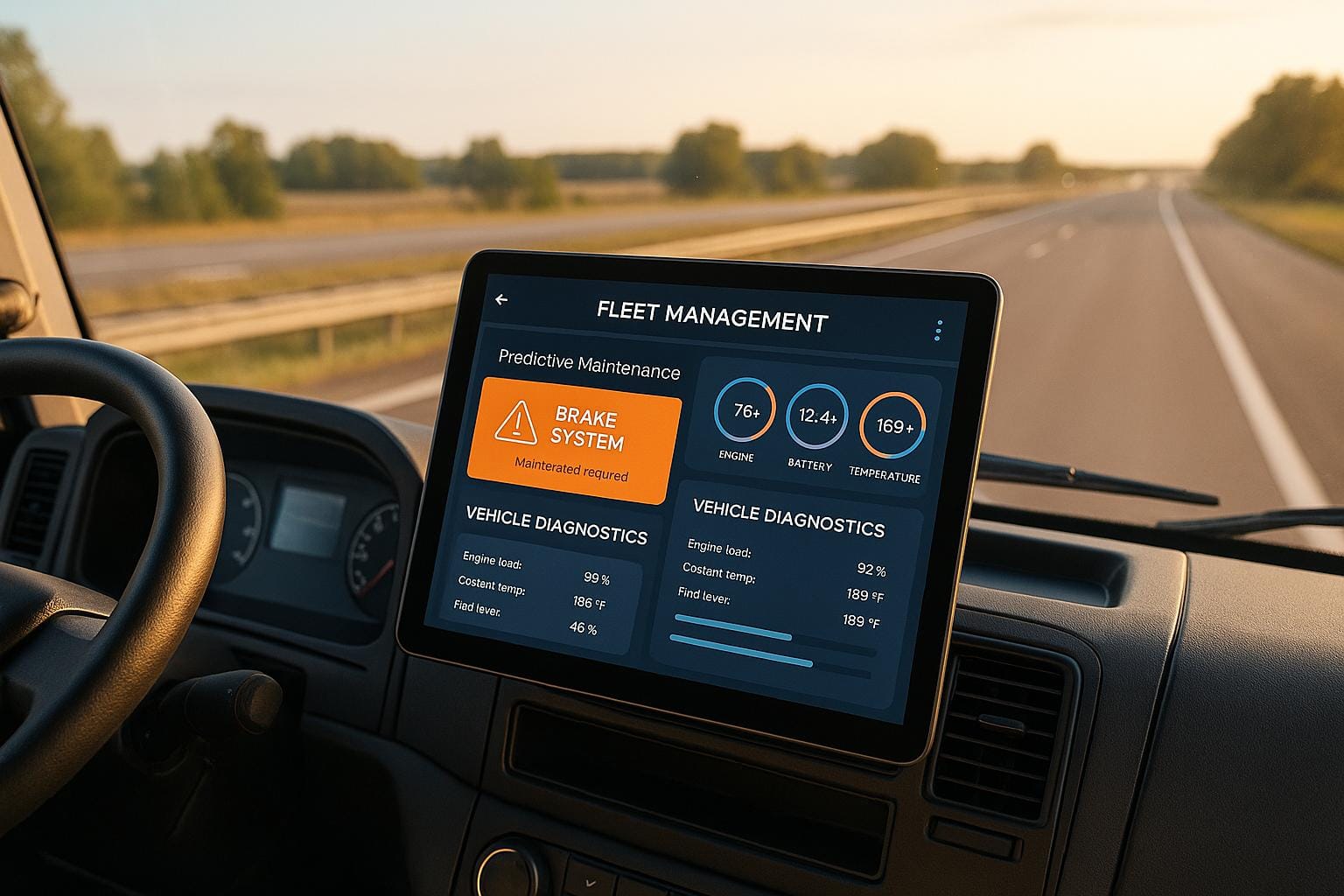Telematics systems are transforming fleet safety by offering tools to monitor drivers, vehicles, and road conditions in real time. For UK fleet operators, these technologies help reduce accidents, improve driver behaviour, and cut costs. Here’s a quick look at the key features:
- Real-time Monitoring: Tracks vehicle location, speed, and driving actions.
- Driver Behaviour Insights: Identifies risky habits like speeding or harsh braking.
- Rest Break Alerts: Ensures compliance with legal driving hours to prevent fatigue.
- Emergency Response Tools: Provides immediate help during accidents or breakdowns.
- Vehicle Maintenance Alerts: Schedules servicing based on diagnostics to avoid costly repairs.
- Route Planning Tools: Adjusts routes for safety and efficiency using live updates.
- Security Features: Includes remote vehicle immobilisation and theft prevention.
Quick Comparison of Features
| Feature | Benefit | Example Tools |
|---|---|---|
| Driver Monitoring | Improves habits, reduces risks | Speed alerts, AI dash cams |
| Emergency Response | Faster help in crises | Panic button, live tracking |
| Maintenance Reminders | Prevents breakdowns | Engine oil, brake checks |
| Route Planning | Safer, efficient journeys | Traffic updates, stop planning |
| Security Measures | Protects vehicles and drivers | Geofencing, dual tracking |
Telematics not only enhances safety but also saves money, with up to 15% fuel savings and fewer claims due to improved driver behaviour. By adopting these systems, fleet managers can prioritise safety while streamlining operations.
How to Improve Driver Safety with Telematics | KERRY ...
Driver Safety Tracking
Telematics provides real-time insights that help fleet managers address unsafe driving habits before they lead to accidents. Here’s how telematics supports safer driving practices.
Speed Limits and Alerts
The system compares GPS-recorded speeds with posted limits and notifies fleet managers when drivers exceed them. This constant monitoring helps minimise speeding, a major factor in crashes.
Key features include:
- Real-time speed tracking based on road-specific limits
- Customisable thresholds for alerts
- Reports on speeding incidents
- Historical data for speed analysis
Unsafe Driving Detection
Sensors track dangerous driving behaviours by measuring g-force impacts. This allows the system to detect:
- Harsh acceleration
- Sudden braking
Research shows that 40% of drivers adjust their behaviour after receiving their first safety warning. Immediate feedback like this can lead to long-term improvements in driving habits.
Driver Performance Reports
A weighted scoring system evaluates driving patterns and generates detailed reports, including driver scorecards. Sharing this data with drivers can encourage better habits.
| Behaviour Category | Score Weight |
|---|---|
| Speeding incidents | High weight |
| Harsh braking events | Medium weight |
| Rapid acceleration | Medium weight |
| Idle time | Low weight |
| Seatbelt compliance | Critical weight |
Rest Break Monitoring
To combat fatigue, the system tracks driving hours and ensures rest breaks are taken. It:
- Monitors continuous driving times
- Alerts managers when breaks are needed
- Tracks compliance with rest periods
- Generates weekly reports
AI-powered dash cams enhance these features by visually confirming driver alertness. When combined with telematics, they can reduce accidents by up to 60%. Together, these tools create a comprehensive system that helps fleet managers uphold safety standards.
Live Safety Warnings
Telematics systems include warning features designed to protect both drivers and vehicles during use. These real-time alerts work alongside driver safety tracking to provide immediate assistance when it matters most.
Crash Prevention Alerts
Collision avoidance systems rely on sensors and algorithms to identify hazards early. They issue instant warnings to help drivers steer clear of accidents. Here's a look at some common features:
| Alert Type | Function | Purpose |
|---|---|---|
| Forward Collision | Tracks distance to vehicles ahead | Helps avoid rear-end accidents |
| Emergency Braking | Activates brakes when a threat is detected | Minimises impact severity |
| Lane Departure | Monitors lane position | Warns against unintentional drifting |
With someone killed or seriously injured on UK roads every 22 minutes, these systems play a crucial role in fleet safety. They also pave the way for more location-specific warnings.
Zone Entry Warnings
Geofencing technology sets up virtual boundaries around specific areas, allowing fleet managers to monitor and control vehicle movements. When a vehicle crosses into or out of a designated zone, the system triggers alerts to help reduce risks in high-danger areas. These virtual zones are used for various purposes:
| Zone Type | Purpose | Trigger |
|---|---|---|
| Construction | Enforce speed limits | Entering work zones |
| Restricted | Block unauthorised access | Crossing boundaries |
| High-Risk | Keep vehicles out of dangerous areas | Proximity alerts |
| Time-Restricted | Manage access during specific hours | Entry at off-hours |
Notifications are sent via SMS, email, or app push alerts, ensuring quick action.
Smart Camera Systems
AI-powered smart cameras monitor driver behaviour and road conditions, issuing real-time alerts for unsafe actions. These systems focus on behaviours like:
| Behaviour Type | Detection Method | Action |
|---|---|---|
| Mobile Phone Use | Visual AI detection | Instant warning |
| Driver Drowsiness | Tracks eye movements | Sends alert |
| Smoking | Recognises objects | Notifies management |
| Seatbelt Use | Confirms visually | Issues reminder |
Video telematics is now the fastest-growing area in fleet technology. Knowing they're being monitored often encourages drivers to adopt safer habits.
Route Planning Tools
Route planning tools, paired with real-time safety and performance tracking, improve both driver safety and delivery efficiency. These tools allow for real-time route adjustments, ensuring safer and more efficient journeys through features like live updates, planned stops, and detailed scheduling.
Live Route Updates
Real-time updates on weather and traffic conditions enable fleet managers to adjust routes as needed. Here's how it works:
| Update Type | Safety Benefit | Driver Impact |
|---|---|---|
| Weather Alerts | Warns of adverse conditions | Allows for safer route changes |
| Traffic Updates | Avoids congestion | Reduces delays and frustration |
With these tools, fleet managers can track driver locations and respond quickly to changing conditions, ensuring smoother operations and safer routes.
Stop Planning
Stop planning ensures drivers stick to legal driving times and take necessary rest breaks. This not only enhances safety but also avoids penalties. As Martin Leszynsky, Fleet Manager at Greif Group, explains:
"If we can only use the system to prevent an administrative offence – such as exceeding driving times – then it has already paid off for us."
– Martin Leszynsky, Fleet Manager, Greif Group
The Greif Group, managing 155 vehicles, uses telematics to monitor driving times and rest periods. This approach helps them meet legal requirements while prioritising driver well-being.
Delivery Schedule Tools
Smart scheduling tools play a key role in balancing safety with efficiency. They account for:
| Factor | Safety Impact | Scheduling Benefit |
|---|---|---|
| Driver Hours | Prevents overwork | Ensures compliance with laws |
| Rest Breaks | Reduces fatigue | Keeps drivers alert and focused |
Even minor breaches of working hours can lead to fines in the tens of thousands. With two-way communication and turn-by-turn navigation, drivers can make better decisions while staying on schedule.
Vehicle Safety Systems
Telematics systems play a key role in monitoring vehicle performance, helping to prevent problems and avoid expensive incidents. For example, crashes can result in costs exceeding £20,000 due to repairs and downtime.
These systems are designed to keep vehicles in top condition, contributing to overall fleet safety.
Service Reminders
Telematics platforms provide maintenance alerts based on real-time engine diagnostics, focusing on a vehicle's actual condition. Key components monitored include:
| Component | Monitoring Parameters | Safety Impact |
|---|---|---|
| Engine Oil | Remaining life, contamination | Prevents engine failure |
| Brake System | Fluid levels, pad wear | Ensures reliable stopping |
| Battery | Charge level, performance | Avoids unexpected failure |
This allows fleet managers to plan maintenance effectively, reducing vehicle downtime and ensuring safer operations.
Vehicle Health Checks
Digital inspection tools simplify daily vehicle checks, complementing driver safety and live alert systems.
"Following a recent demonstration of Checked Safe I was impressed with the legal compliance this simple yet robust app provides. Used correctly this will protect both driver and operator. Undertaking defect reporting is always a hot topic with the Traffic Commissioner and the DVSA, I believe this ticks the right boxes."
These systems also track warranty details and maintenance history, ensuring compliance and helping recover costs for covered repairs. This organised approach supports high safety standards while minimising operational disruptions.
Fuel Use Monitoring
Fuel monitoring systems use machine learning to evaluate driving habits and fuel consumption. The Fuel Store's AI technology showcases how these systems enhance both safety and efficiency:
| Monitoring Aspect | Safety Benefit | Efficiency Gain |
|---|---|---|
| Acceleration | Flags aggressive driving | 5–9% fuel savings |
| Braking Behaviour | Identifies safety risks | Reduces wear and tear |
| Cornering | Detects unsafe manoeuvres | Lowers accident risk |
Green Driving collects and analyses data, helping fleet managers promote safer, more efficient driving habits. This not only reduces costs but also encourages responsible driving practices.
Security Features
Telematics incorporates multiple layers of security to protect vehicles and drivers from theft while ensuring quick emergency responses. These features enhance earlier safety and performance measures, providing added protection.
Backup Tracking System
The dual-tracking system ensures uninterrupted monitoring by using two independent devices. This setup guarantees tracking remains active even if the primary device is compromised.
| Component | Function | Security Benefit |
|---|---|---|
| Primary Tracker | Provides real-time GPS tracking | Keeps location updates current |
| Secondary Bluetooth | Acts as a backup via Bluetooth | Operates independently |
| IMEI Forwarding | Switches systems automatically | Maintains tracking continuity |
Remote Vehicle Control
Fleet managers can take remote actions to enhance security, including:
- Immobilising a vehicle if theft is detected
- Monitoring the engine's operational status
- Managing access through digital authentication
- Tracking fuel levels to deter fuel theft, a critical feature since three out of ten engines operate on stolen fuel
Emergency Help Tools
Emergency response tools enable fast, monitored assistance through an integrated system.
| Tool | Function | Response Time |
|---|---|---|
| Panic Button | Connects instantly to the monitoring centre | Immediate alert |
| Video Streaming | Provides live video for situation assessment | Real-time feed |
| Asset Distance Alerts | Tracks spacing in convoys | Instant notification |
| Precise Location Data | Uses reverse geocoding with milepoint details | Under 30 seconds |
Additionally, emergency features are secured with two-factor authentication and rigorous session management protocols.
Conclusion
Telematics enhances fleet safety management across the UK by combining driver monitoring, live alerts, route planning, vehicle health checks, and security measures. Together, these features not only improve driver behaviour but also boost operational efficiency.
Fuel savings are another key benefit. Vehicles equipped with telematics systems can reduce fuel consumption by up to 15%. For a vehicle spending £100 on fuel weekly, this could mean annual savings of around £780. These savings come alongside better driver protection and stronger fleet security.
Key safety features include:
| Safety Component | Primary Benefit | Measurable Outcome |
|---|---|---|
| Safety Monitoring | Better driving habits | Reduces collision risks caused by errors |
| Emergency Response | Quicker incident handling | Saves an average of £2,000 per claim |
| Zone Management | Improved compliance | Real-time monitoring of restricted areas |
| Location Tracking | Enhanced security | Continuous tracking for uninterrupted coverage |
This integrated system not only cuts costs but also lowers claims, as highlighted by industry professionals:
"We have used the readily available information to provide refresher training and reminders that have benefitted our drivers. We have seen a positive reduction in claims." - Hayley Norman, Manager, RMS Goole Limited
Features like speed monitoring, rest break tracking, and vehicle health checks allow fleet managers to address safety concerns before they escalate. Real-time monitoring and automated alerts ensure high safety standards while keeping operations compliant with regulations.
UK fleet operators adopting these telematics solutions improve driver welfare and streamline operations. By using these interconnected systems, fleet managers create a continuous cycle of safety improvements.




